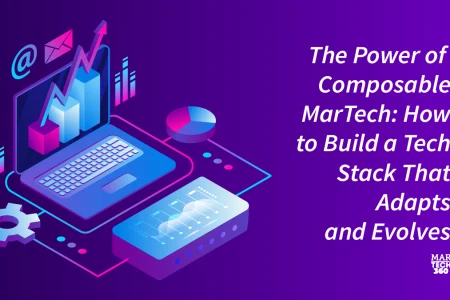In today’s fast-paced world, the marketing technology (MarTech) stack is vital for businesses. It helps them stay competitive. However, The MarTech landscape has become more complex than ever, with over 14,000 tools and platforms.
Amid this complexity, the concept of composable MarTech stands out as a beacon. These composable tech stacks offer flexibility to adapt and evolve according to business needs. Additionally, they ensure that technology investments continue to drive value over time.
In this thought leadership article with inputs from Frans Riemersma, we will explore the challenges, benefits, and strategies to make MarTech stack composable.
Understanding Composability in MarTech
Composability in MarTech refers to the ability to build and modify your tech stack in a modular fashion. It includes selecting and combining the specific features and tools that serve the best for your business needs. Unlike rigid, one-size-fits-all solutions, a composable approach allows marketing teams to create a tailored ecosystem of tools. This curated ecosystem works cohesively to deliver superior customer experiences.
According to Frans Riemersma, composability is more than just about choosing the right tools. It is about leveraging the right features within those tools.
“Technology itself doesn’t solve problems; it’s the specific features within that technology that drive real value. In fact, our research shows that only 20% of a tool’s features deliver 80% of its impact. This is the essence of composability. It is not about the tool, but how you strategically combine its elements to create seamless and delightful customer journeys. The magic lies in orchestrating these features to elevate the customer experience,” he says.
This approach shifts the focus from the technology to the strategic use of its components. As a result, businesses are able to achieve the desired results.
Also Read: 17 Ways to Transform Customer Experience with Generative AI
Overcoming Challenges in Composable MarTech

Composable pre-sales tech stack has many benefits but also poses challenges. One major issue is the risk of relying too much on technology, neglecting human insight. Frans warns marketing leaders about this. He urges marketers to use technology to gain deeper customer insights, not just automate processes or CRM campaigns.
Another challenge is the pressure to adopt the latest tools. This is often done without understanding their value or fit in the existing tech stack. Riemersma’s advice is simple: focus on the basics first. “Outperformers don’t have the latest, best-of-breed software; they have firm, solid basics,” he notes.
By mastering the fundamentals, companies can avoid being distracted by shiny new tools. These shimmering tools don’t necessarily drive business results. The rise of gen AI and machine learning is set to play a crucial role in enhancing MarTech capabilities. These technologies enable real-time data analysis and personalized customer interactions. However, it is crucial to determine its value in your business processes first and then integrate them.
The Benefits of Having a Composable MarTech Stack
Building a composable tech stack offers several benefits to the organization. Particularly for pre-sales activities, where adaptability and responsiveness are key. The following are the top advantages:
1. Flexibility to Adapt
With a composable approach, businesses can easily swap out individual components of their stack. It allows organizations to adapt to evolving market conditions, customer needs, or technology trends. As only about 20% of a tool’s features drive 80% of its value, so focusing on these key features allows for greater adaptability without the need for complete overhauls.
2. Customer-Centric Focus
There is a critical issue in MarTech today. Many companies become so focused on implementing new tools that they lose sight of the customer. A composable stack keeps the customer at the center of decision-making. This allows marketers to prioritize tools and features that improve the customer journey.
3. Cost Efficiency
A composable stack helps businesses avoid unnecessary expenses on underutilized tools. Organizations only invest in the essential features that deliver value. This targeted investment approach ensures that each dollar spent on MarTech contributes to the overall revenue. Enterprises can optimize the efficiency of the pre-sales process with composability.
Strategies to Build Your Composable MarTech Stack
Creating a composable technology stack begins with understanding your customer’s journey. Marketing decision-makers should align their technology investments accordingly. Frans suggests a systematic approach to building a tech stack that is both flexible and effective:
1. Start with the Core MarTech Platform
Think of your core platform as the sun in your MarTech solar system, with other tools revolving around it. The choice of a center platform should depend on your core business needs and data requirements. A core MarTech platform like CDP gathers, stores, and manages customer data centrally. This unified data source ensures accuracy, enhances segmentation, and enables personalized marketing.
2. Evaluate Integration Capabilities
Integration is at the heart of a composable MarTech strategy. The core platform must have strong integration capabilities. It should include APIs, iPaaS (Integration Platform as a Service), or native integrations. These tools ensure seamless integration with other marketing tools. Businesses should assess a tool’s integration ecosystem before adding it to their stack.
3. Adopt a Plug-and-Play Architecture
One of the biggest challenges with traditional MarTech stacks is the lack of a clear decommissioning plan. A plug-and-play architecture can help address this issue. This architecture makes it easier to add, remove, or replace tools as needed. It minimizes disruptions and ensures the tech stack remains agile and aligned with your evolving goals.
4. Take the Hack, Pack, and Stack Approach
Riemersma’s mantra of “hack, pack, and stack” offers a practical framework for MarTech experimentation and implementation.
“In MarTech, there’s a false dilemma that suggests we must choose between a flexible stack and a scalable, IT-driven one. The truth is, we need both. Our core platforms should be stable and revenue-driving, while our approach to experimentation must be agile and adaptable. It’s all about hacking to test new ideas, packing to refine and streamline, and then stacking to integrate the essentials into our core systems. The key is a disciplined handover from marketing to IT, ensuring a lean, focused stack that aligns perfectly with business goals. Remember: Hack, Pack, and then Stack,” he adds.
Decision-makers should start by hacking and experimenting with new tools and features to see what works. Then, pack by streamlining and cleaning up the data gathered for each tool and feature. It is crucial to remove any elements that don’t add value. Finally, stack, by integrating these refined components into your core MarTech infrastructure.
With the hack, pack, and stack approach, stakeholders can ensure they deliver measurable results. For instance, marketing leaders can experiment with marketing automation, gather necessary data, and then integrate it into the tech stack based on results.
The Future of Composable MarTech
A composable tech stack’s power lies in its ability to evolve with your business and adapt to a changing market. As Frans Riemersma aptly puts it, “It’s the features, not the technology,” that create meaningful customer journeys and drive value.
Looking ahead, a customer-centric, composable MarTech stack will be even more important.
For CMOs and marketing leaders, the key takeaway is clear: invest in a MarTech stack that is flexible and composable. The stack should also be deeply aligned with your customer’s needs and business goals. By doing so, you’ll future-proof your marketing efforts and drive long-term growth and success in an ever-evolving digital landscape.

